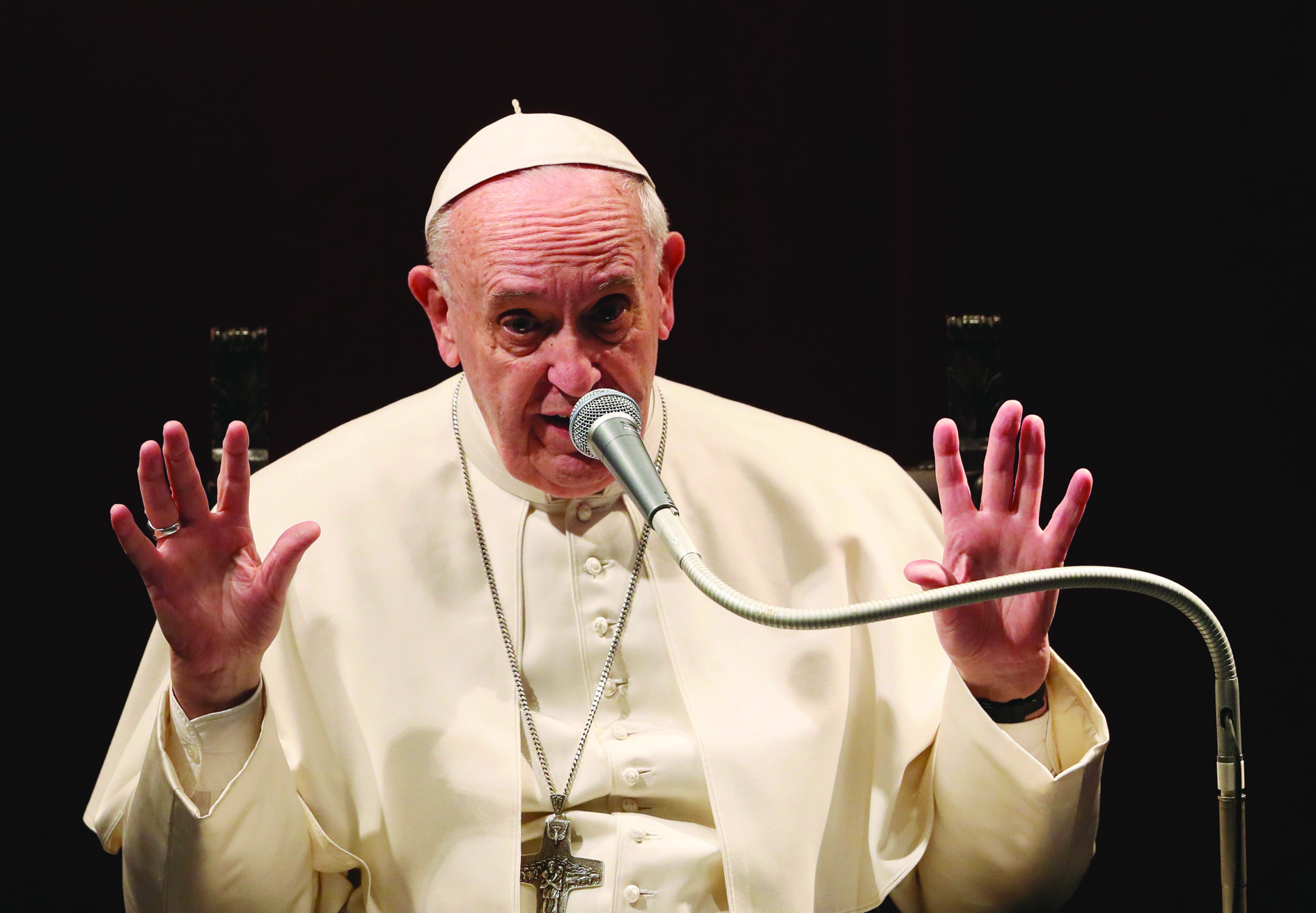“Of course they were,” Justus George Lawler responds to the question he poses in the title of this book. If we ask, however, whether the Popes were “disdainful, contemptuous and vengeful toward Jews and their beliefs” (as claimed in a flood of recent works by a gaggle of left-wing Catholics, nonbelievers, and Jews), the answer, Lawler writes, is “completely different and far more complex.”
The anti-Judaism of Popes down through the ages was religiously based. Modern anti-Semitism is racial and anti-religious. It arose only in the nineteenth century, inspired by secular and anti-Christian ideology. The charge of our contemporary anti-papal writers, “No Vatican, No Holocaust,” is one of the many myths convincingly refuted by Lawler in this book — all of them products of ideology, not history.
The pontiffs whom Lawler examines go back no farther than Pius IX, Pope from 1846 to 1878, when modern racist anti-Semitism was germinating. From his time onwards, the Popes, according to the Brown University professor, David L. Kertzer, whose 2001 book, The Popes Against the Jews, Lawler examines in lengthy detail, were allegedly secretly plotting against the Jews “out of the limelight,” without ever condemning them publicly. But such a charge comes from the shadowy world of conspiracy theories, not scientific history.
Kertzer’s indictment contains four counts: that Pope Pius IX called the Jews dangerous “dogs” harassing the citizens of Rome; that he and Pope Leo XIII (1878-1903) labeled Jews “the synagogue of Satan”; that he and Pius X (1903-1914) not only gave credence to the “blood libel” (that Jews killed Christian children for use in religious rituals) but knowingly prevented Jews falsely accused of such crimes from being exonerated; and that as nuncio to Poland, Achille Ratti, the future Pius XI (Pope from 1922 to 1939), fostered anti-Semitism and embraced people who advocated the extermination of Jews.
If even one of these charges were true, it would be a damning indictment indeed. But Lawler shows that all are the result of doctored citations, tortured logic, jumbled chronology, and suppression of exculpating evidence in the sources upon which Kertzer bases his indictment – indeed sometimes on the very pages from which he quotes.
To support his charge that Pius IX called the Jews of his day “dogs,” Kertzer avoids citation of the Pope’s words. Instead he offers his own inaccurate paraphrase. Read in context, it is clear that the Pope’s words refer not to Jews but to Gentile enemies of the Church. Similarly with the same Pope’s mention of a “synagogue of Satan” in an 1873 encyclical: he was referring not to Jews, but to “sects” — in that day the term for “Secret Societies”, i.e. Freemasons.
As for the blood libel, it was repeatedly condemned by the Popes. When the Jew, Mendel Beilis, was on trial in 1913 before a Russian court in Kiev, accused of killing a Christian child for ritual purposes, the Vatican complied with the request of Beilis’s defense attorney to supply a document confirming papal condemnation of the blood libel. That it did not reach the court until the trial was over was due not to foot-dragging in Rome (as Kertzer claims), but to deliberate delay by the Russian ambassador, who subsequently bragged of his accomplishment. Moreover, the reigning pontiff, Pius X (who as bishop of Mantua had said, “as far as charity is concerned, Jews are the best Christians”), prayed “that the trial will end without harm to the poor Jews.”
Achille Ratti, later Pope Pius XI, was papal representative in Poland (first as apostolic visitor, then as nuncio) from April 1918 to June 1921. By confining his analysis to only a few months of this more than three-year period, by citing documents sent to him by anti-Semites as if they represented Ratti’s own views, and by claiming that Ratti had only a single meeting with Jews, Kertzer manages to characterize Ratti as an anti-Semite whose later reign as pontiff constituted an “antechamber to the Holocaust.” In reality, Ratti had a number of always cordial meetings with Jews in Poland, and addressed them in Hebrew, which he boasted he had learned from his longtime personal friend, Alessandro De Fano, Chief Rabbi of Milan.
Ratti’s interest in Hebrew helps explain why, as Pius XI, he told a group of Belgian pilgrims in a private audience on September 6, 1938, that “anti-Semitism is incompatible with the sublime thought and reality” of what he called the “magnificent” Old Testament texts about Abel, Melchisedech, and Abraham, “our Patriarch, our Ancestor.” Choking up and scarcely able to go on, the deeply emotional pontiff cited texts from St. Paul to show Christians’ spiritual descent from Abraham. Because the audience was private, the Pope enjoined those present to give his statements the widest possible publication – which they promptly did.
Kertzer’s deeply flawed indictment has been praised in print and at academic conferences by sycophantic peers eager, like Voltaire, to écrasez l’infâme of an institution claiming divine authority while allegedly holding mankind in ignorance and bondage. Through meticulous analysis, Lawler shows their writings to be as flawed as those of the man they celebrate as “a national treasure” for having driven the final nail into the coffin of the papacy as an organ of human compassion and enlightenment.
One of the best known is the English journalist John Cornwell, author of the sensationally titled 1999 book, Hitler’s Pope: The Secret History of Pius XII. Cornwell informed readers that his work was the result of research in the Vatican archives for “months on end.” The official archival records show that he was there from May 12 to June 2, 1997. Lawler dismisses the book as “trash talk with footnotes.” After profiting handsomely from his royalties, Cornwell modified or withdrew some of his more egregious charges.
Another papal critic, John Connelly, professor of history at the University of California, Berkeley, extends the indictment to the present Pope, by putting into Benedict XVI’s mouth words he never uttered. Even more scandalous is the attack by Beth A. Griech-Pollele on the bishop of Münster, Clemens August von Galen, now beatified for his courageous sermons denouncing Hitler’s crimes in the summer of 1941. She mistranslates a September 1941 letter from Pope Pius XII to Bishop von Preysing of Berlin, claiming that it ordered the German bishops “not to protest.” What the Pope actually wrote was that he fully supported the decisions of bishops on the spot about how and when to protest; but that he, as leader of the whole Church, must exercise restraint. Griech-Pollele’s mistranslation is the basis for her claim, repeated by her fellow historian, Michael Phayer, that Pius XII’s giving cardinal’s hats to von Galen, von Preysing, and Frings (archbishop of Cologne) in February 1946 was a reward for their having obeyed his order to keep silent. This is preposterous. Exactly the opposite is true.
In the final chapter of his book Lawler introduces the experience of the Jewish refugee Heinz Wisla at a public audience with Pius XII in the autumn of 1941, attended by many German soldiers. As soon as Wisla had identified himself as a Jew, the Pope raised his voice so that everyone in the audience hall could hear him and told Wisla: “My Jewish friend, go with the protection of the Lord, and never forget, you must always be proud to be a Jew!” Nor was the Pope’s concern merely a matter of words. He asked Wisla to submit an account of the Italian prison camp, on the island of Rhodes, from which he had escaped; and Pius, according to Wisla’s memoirs, subsequently arranged to have Wisla’s friends – some 500 starving Jewish refugees still trapped there – transferred to a humane camp on the Italian mainland, where they survived. This little-known but remarkable papal intervention was confirmed by another first-hand Jewish witness, Herman Herskovic, who wrote after his escape to the United States that he owed his life to Pius XII. Had the Pope not acted, those 500 Jews would have almost certainly lost their lives, since the Nazis subsequently took over Rhodes and killed virtually all its indigenous Jews.
Lawler’s book is a notable example of successful historical revisionism; but he makes severe demands on the reader. This reviewer had to re-read a number of passages to fully understand the author’s intricate literary and historical analysis of his opponents’ claims and counter-claims.
In a damning indictment of today’s professoriat, who distort and suppress the historical record to defame Churchmen who struggled to do good according to the lights of their day, Lawler several times cites the published wartime diaries of the German Jewish professor of literature, Victor Klemperer, expelled from university teaching by the Nazis in 1935, who managed to survive the war because of his Aryan wife. Had he been able, after the war, to mete out justice to his vanquished countrymen, Klemperer writes, “I would have all the intellectuals strung up, and the professors three feet higher than the rest.”
Lawler never minimizes the suffering of the Jewish people. In what could well serve as a summation of his case, he notes early in his book that Kertzer deplores the “demonization” of Jews by the Church through its long history of anti-Judaism. Lawler concedes the charge, but adds: “One has to wonder whether employing the same contemptuous language for Churchmen does not also place him among the unwashed demonizers.”






Facebook Comments